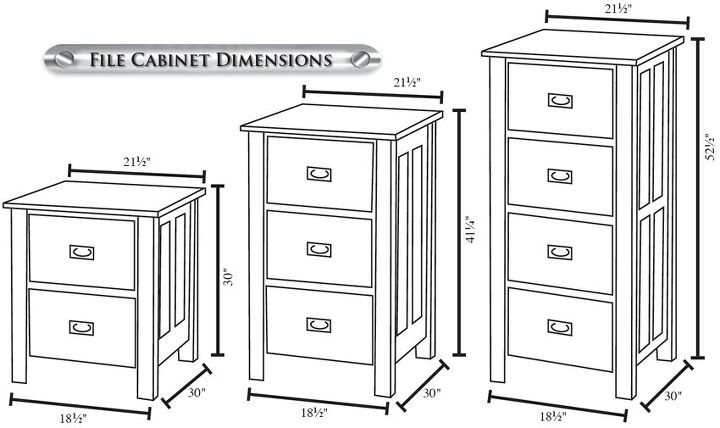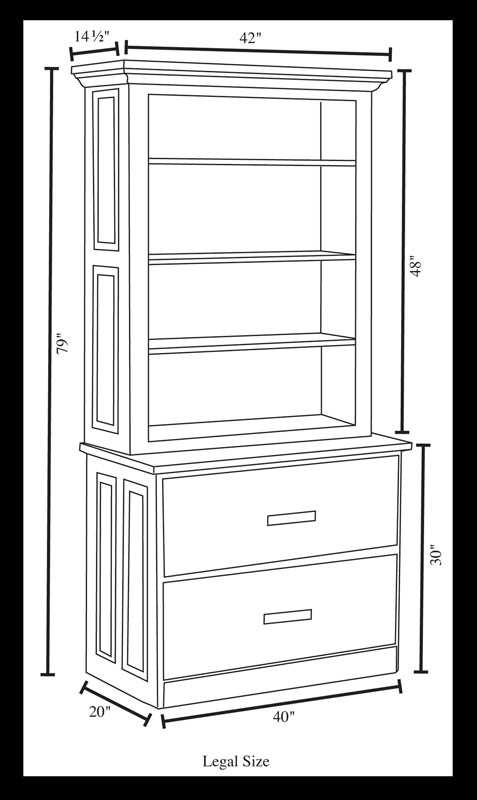2 Drawer Vertical File Cabinet Dimensions
File Cabinet Dimensions (with Drawings)

Whether in a home office, for personal papers, or a business, file cabinets are often key storage pieces. They help keep important documents organized and in one place, and many feature locks to protect sensitive information. Of course, people need to file various amounts of papers, so luckily, file cabinets come in many styles and sizes.
A typical two-drawer vertical letter file cabinet is roughly 15 inches wide, and one for legal-size files is about 18.25 inches. They usually have two to five drawers, so the height can range from approximately 29 to 60 inches. Typically, they're 28 to 30 inches deep, but there are shallower options available too.
You can find larger styles with hutches or open shelves or extra-wide lateral units, so you have many options. However, it's essential first to know exactly what you'll use the filing cabinet for (I.e., home office, personal records, and bills). Then, you can better determine precisely what style of file cabinet you should get to best suit your needs.
Table of Contents
- Things to Consider When Choosing a Filing Cabinet
- Fire-Proof File Cabinets
- Make Sure the File Cabinet Is Sturdy
- Choose Your Style of File Cabinet
- Standard Vertical File Cabinets
- Storing Legal-Sized Papers in a File Cabinet
- Other File Cabinets
- A File Cabinet with a Hutch
- Lateral Filing Cabinets
- Open-Shelf Files
- Rolling File Cabinets
- Clearance Needed for a File Cabinet
- Related Questions
-
- How much is a file cabinet?
- What are alternative filing solutions if I need to bring my papers with me on business trips?
-
Things to Consider When Choosing a Filing Cabinet
When selecting a file cabinet, size isn't the only thing that matters. You also want to think about specifics like security, file orientation, and style. For example, many file cabinets feature locks and keys so you can keep your files secure. Other cabinets are fire-proof, so your important papers don't get damaged in a fire.
Fire-Proof File Cabinets
Fire-proof cabinets typically feature ratings that signify how high of a temperature they can withstand. Typically, they will resist heat up to roughly 355 degrees Fahrenheit. Some cabinets include an additional characteristic and can handle higher heat (up to 1,700 degrees) for about an hour.
Make Sure the File Cabinet Is Sturdy
When purchasing a file cabinet, don't skimp when it comes to sturdiness. A full drawer of files can weigh anywhere from 250 to 310 pounds. File cabinets should handle this weight but beware of cheap versions that might not be up to snuff.
Choose Your Style of File Cabinet
File orientation refers to how you access the folder in your file cabinet. For example, a vertical file cabinet places files horizontally in the drawer. Therefore, you look through them from the front of the drawer to the back.
Conversely, lateral file cabinets, which are typically wider than deep, position files vertically in the drawer. Therefore, you look through files from side to side if you're in front of the cabinet. Or you can stand to the side of it to look at them from front to back.
Some file cabinets are no-nonsense metal units, while others look more like a piece of nice furniture. You can get cabinets of varying heights; some have removable hutches or shelves, while others are portable. Check your office desk dimensions to see if a file cabinet can fit underneath it to maximize space.
Of course, you also need to consider the logistics, like your available space. It does you no good to get a fancy, deluxe file cabinet if you can't fit it in your office.
Standard Vertical File Cabinets
The most common type of file cabinet is a vertical letter-file cabinet. You can typically find these in either two, three, four or five-drawer configurations.
The cabinet is about 15 inches wide and roughly 28.5 to 30 inches deep. Furthermore, one drawer can hold up to 27 inches of files. However, there are some shallower models, which of course, hold fewer files.
For example, some cabinets are 26.5 inches deep and only hold about 25 inches of files. Then, 25 inch deep cabinets only hold about 23.5 inches of files.
The height of the cabinet depends on the number of drawers. For example, a two-drawer vertical file cabinet is about 29 inches tall, and a three-drawer is roughly 40 inches tall. If you need to store many files, you might want to consider a four or five-drawer cabinet.
A four-drawer cabinet stands about 52 inches tall, and a five-drawers file cabinet is about 60 inches tall. Look for mold if there is a strange odor coming from your cabinets.
Storing Legal-Sized Papers in a File Cabinet
If you need to store legal-size files, you'll need a legal-size file cabinet. Otherwise, you need to fold your papers, which not everyone likes to do.
Legal-size file cabinets have similar heights and depths to letter-size cabinets but measure about 18.25 inches across. If you have files of both sizes, you might want to consider going with an 18.25 to 18.5-inch cabinet. This way, you can comfortably fit all of your papers in one place.

Other File Cabinets
Beyond standard vertical file cabinets, there are several other options available. Some are more commonly found in settings like doctor's offices and other businesses. But, knowing your options helps you decide which style of file cabinet is the best fit for your needs. You can fix a particle board cabinet even if it is wet.
A File Cabinet with a Hutch
If you prefer a less utilitarian-looking file cabinet in your home office, consider one that blends in with your furniture. This is also a good idea if you simply need a couple of file drawers for personal papers and bills. Then, if you don't have a dedicated home office, you can keep your files in a living room or den.
Instead of looking like a file cabinet, these pieces look like bookcases or part of built-ins. For example, this piece from Ohio Hardwood Furniture features two lateral file drawers with a removable hutch on top. You can use the shelves to display books, decorative items, and other odds and ends.
The file cabinet is a typical size for a two-drawer lateral cabinet. But, then, if you opt to use the hutch, the whole piece measures roughly 79 inches tall.

Lateral Filing Cabinets
A lateral file cabinet simply features drawers that are wider than they are deep. This is the type of cabinet that places files vertically in the drawer. So, you stand to the side as you look through files.
However, some models feature double rows of files in each drawer. In this case, you would flip through files from front to back like you would with a standard file cabinet. Either way, lateral file cabinets come in various sizes and usually feature between two and five drawers.
Typical widths are 30, 36, 38, 42, or 44 inches wide. Typically, whatever the width, you can hold about 2.5 inches less of files. Lateral file cabinets might only be about 15 to 20 inches deep.
The heights vary based on drawer count. For example, a two-drawer cabinet is about 28 inches tall, and a three-drawer cabinet is about 40 inches tall. Finally, the four-drawer cabinet ranges from 50 to 53 inches tall, while the five-drawer measures 64 to 66 inches tall.
This USM Haller File Credenza features two lateral cabinets side-by-side to create a large file storage area. It measures 15 inches deep by 29 inches tall. It's 60 inches wide, with each set of drawers measuring 30 inches across.

Open-Shelf Files
These types of file systems are usually found in doctor's offices. They feature open shelves with vertical supports spaced throughout to hold files upright. There are no drawers, and people typically use color-coded tabs to locate files quickly. Many rolling file cabinets are compatible with L-shaped desk dimensions.
Rolling File Cabinets
If you need to transport your files from one room to another, a portable file cabinet is a good choice. It's also suitable for a shared office space when someone needs to have the files by their desk, etc.
This IKEA Drawer Unit can slide under a desk, at 21.625 inches tall and 23.625 inches deep. It's also 17.75 inches wide. It features one bottom drawer for files with a smaller upper drawer for office essentials.

Clearance Needed for a File Cabinet
In addition to the space necessary to fit the actual file cabinet, you need to leave room in front of it. When the drawer is fully extended, a standard cabinet can take up about 4.5 feet of floor space. A lateral cabinet takes up about 3 feet of space with a fully opened drawer.
According to the ADA, you should leave 3.5 feet of space in front of the open drawer. But, of course, in your home office, this doesn't necessarily apply.
But, you want to ensure you can at least pull the drawer out entirely and access your files comfortably. If you're planning to put the file cabinet under your desk, make sure to leave room for your knees, etc.
How much is a file cabinet?
The price of a file cabinet varies greatly since there are so many different factors to consider. For example, a basic, vertical two-drawer unit might cost you about $20. But, a five-drawer metal cabinet could cost closer to $300.
However, if you select cabinets that blend in with furniture, have fire-proof qualities, and other features, you'll spend more. Larger cabinets made of high-quality materials and showcasing lots of features can cost upward of $1,000. Since there are so many options, shop around a bit before you make a final purchase.
What are alternative filing solutions if I need to bring my papers with me on business trips?
If you need to transport field with for business, you can purchase expanding accordion files in a variety of sizes. Some expand to hold 60 pockets or more for folders and can be the same size as a file drawer. In addition, some portable file holders even have fire-proof and water-proof features.
Stacy Randall
Stacy Randall is a wife, mother, and freelance writer from NOLA that has always had a love for DIY projects, home organization, and making spaces beautiful. Together with her husband, she has been spending the last several years lovingly renovating her grandparent's former home, making it their own and learning a lot about life along the way.
Recently Published
Is Drip Edge Required By Code?
There is a never-ending list of codes that your home must be compliant with in order to pass inspection. Roofs are among the most susceptible to inspection issues and can be the reason why your house...
Is Surge Protection Required By Code?
The most common causes of electrical surges come from internal sources within your home, which can send hundreds of thousands of volts through your system at once. When the voltage goes up...
2 Drawer Vertical File Cabinet Dimensions
Source: https://upgradedhome.com/file-cabinet-dimensions/
0 Response to "2 Drawer Vertical File Cabinet Dimensions"
Post a Comment